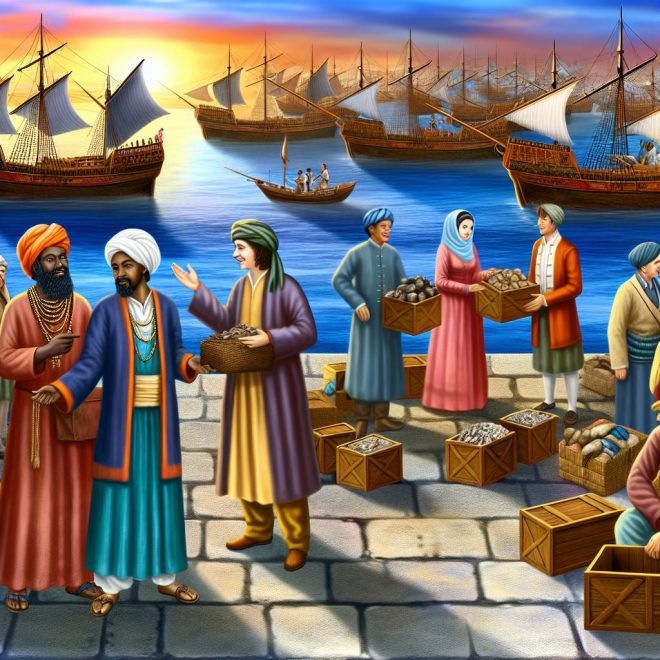The Historical Context of Maritime Trade on the Silk Road
The significance of maritime trade in the expansion of the Silk Road economic networks is both profound and enduring. While the term “Silk Road” often conjures images of camel caravans traversing vast deserts and mountain passes, maritime trade routes were equally, if not more, essential to the exchange of goods, ideas, and cultures across continents. These sea routes complemented the overland paths, creating a web of trade connections that facilitated commerce between distant regions.
The Emergence of Maritime Trade
The growth of maritime trade along the Silk Road can be traced back to the 2nd century BCE when the demand for silk and other luxury goods began to grow outside China. As the Roman Empire expanded, so did their appetite for Asian commodities, driving the development of maritime routes that would connect Asia with Europe and Africa. These routes primarily included the South China Sea, the Indian Ocean, and the Arabian Sea.
The inclusion of maritime routes in Silk Road trading networks marked a significant evolution in global commerce. The sea lanes provided more direct and often faster alternatives to the age-old overland pathways used by traders. This shift was largely due to improvements in maritime technology and an increasing understanding of seasonal wind patterns such as the monsoons, which greatly facilitated travel and commerce across the Indian Ocean.
Key Maritime Routes
Maritime trade expanded the network of the Silk Road significantly, offering quicker and more efficient transportation of goods than overland routes. Some of the most pivotal maritime routes included:
The South China Sea Route: This route linked China with Southeast Asian states and played a vital role in trade with the Indian subcontinent. Merchants traveling the South China Sea exploited the monsoon trade winds to facilitate trade, which involved not just luxury commodities, but also everyday items that contributed to the economic vitality of the region.
The Indian Ocean Route: Connecting the eastern and western parts of the world, this route was instrumental in trading between India, the Middle East, and Africa. The Indian Ocean trade network effectively turned it into a bustling hub of economic activity where various civilizations intermixed, contributing to the cultural and technological advancements that would shape the medieval world.
The Arabian Sea Route: This route pivoted towards the Arabian Peninsula, extending the reach of Asian products into the Mediterranean region and vice versa. This commerce not only brought tangible goods but also facilitated a cross-pollination of ideas and culture, as Arab traders carried with them knowledge that would later influence European medieval thinking.
Goods Traded Through Maritime Routes
A diverse array of goods was exchanged along these maritime trade routes. In addition to silk, which was in high demand across Europe and the Middle East, other commodities included:
**Spices**: Such as pepper, cloves, and cinnamon, were highly prized in European markets. The spice trade was so lucrative that it spurred many European explorations and eventually led to the discovery of new sea routes to the East.
**Precious stones and metals**: Including gold, silver, and gemstones like lapis lazuli and jade. These items were often lavishly traded and used in the adornment or embellishment of aristocratic lifestyles across the globe.
**Textiles**: From cotton to wool, complemented the famous silk fabrics, highly sought after by the European elite. Textile trade stimulated the interaction between different manufacturing techniques and aesthetics, as seen in the blending of style across various cultures.
Moreover, these maritime routes were not merely channels of commerce but also of technological and cultural significance.
The Technological and Cultural Impact
Maritime trade did not merely facilitate the exchange of goods; it also encouraged technological advancements and cultural exchanges. Technological enhancements in shipbuilding and navigation developed out of necessity due to extended seafaring voyages. This included the use of more sophisticated compasses and the creation of more resilient ships capable of navigating tumultuous seas.
Advancements in navigation, particularly the development of the magnetic compass by the Chinese, transformed how sailors guided their voyages across open waters. Maritime nations innovatively adapted these technologies, boosting their trading capabilities and establishing extensive maritime networks that would dominate global trade for centuries.
Cultural Interactions and Influences
The impact of maritime Silk Road trade extended well beyond economics. It played a crucial role in the exchange of cultures, beliefs, and ideas. Traders, merchants, and sailors not only carried goods but also transmitted languages, religious beliefs, and cultural practices across the continents, often leading to a rich tapestry of multicultural societies in port cities.
As port cities grew in importance, they became melting pots of cultural exchange where architecture, cuisine, and social customs merged. This blending laid the groundwork for cosmopolitan centers that celebrated diversity and facilitated the synthesis of new cultural paradigms. Moreover, religious dissemination through these routes was notable, where Islam, Buddhism, and Christianity found pathways to spread and intertwine across different regions.
These maritime interactions set the foundation for long-lasting relationships among diverse cultures and civilizations, leading to an integrated historical heritage that continues to manifest in contemporary global economic and cultural systems.
For further understanding of how these historic trade networks have shaped modern economic partnerships, one might explore contemporary research provided by economic and historical institutions. Online resources, for example, can be accessed through various academic articles and history-focused organizations exploring the evolution of global trade networks rooted in ancient practices.
In conclusion, the role of maritime trade in the Silk Road economic networks cannot be overstated. While the land routes facilitated commerce across vast stretches of Asia, the maritime routes ensured that these economic activities were part of a global network. Through seafaring trade, the Silk Road network established enduring economic, technological, and cultural legacies that continue to influence the world today. The thorough integration of these maritime routes essentially laid the foundation for the interconnected world we experience now, highlighting their historical importance and ongoing relevance.
